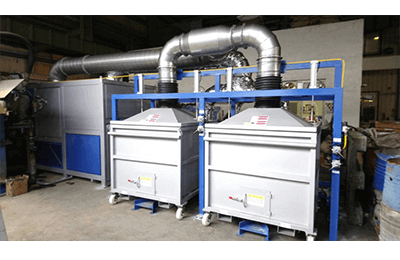What Is a Low Temperature Dryer?

Low Temperature Dryer is a device that uses lowered temperature air to dry materials.
They are used for drying wood, food, pharmaceuticals, paper products, etc. Unlike conventional hot-air dryers, Low Temperature Dryers use relatively low temperature air (approximately 15°C to 35°C) to dry materials while reducing energy consumption. Energy and quality-related innovations have been developed to suit a variety of products and materials.
Because they can dry stably throughout the year and are not affected by outside air or humidity, they are widely used in the food processing industry.
Applications of Low Temperature Dryer
Low Temperature Dryers are mainly used in food processing, wood processing, pharmaceutical manufacturing, paper industry, and in the drying of biological samples.
1. Food Industry
In food processing, drying using low-temperature air minimizes deterioration of taste and nutritional value. The drying process is efficient throughout the year while maintaining temperatures similar to those of drying using outside air.
Evaporation of moisture allows for longer shelf life while maintaining food quality.
2. Wood Processing Industry
Wood drying is important to improve product quality and longevity. Low Temperature Dryers are used to dry wood to the proper moisture content to minimize splitting and warping and improve the stability of the processed product. This is especially useful to avoid wood deterioration caused by high temperatures.
3. Pharmaceutical Manufacturing
Low Temperature Dryers are used in the manufacture of pharmaceuticals and medical devices to maintain product stability and quality. They are especially useful when high temperatures may affect the efficacy and safety of drugs.
4. Paper Industry
Low Temperature Dryers are used in the production of paper and paper products to control humidity and maintain uniform quality. Uniform drying prevents paper from drying shrinkage and distortion, resulting in the production of high quality products.
5. Drying of Biological Samples
Low Temperature Dryers are used in research and medical institutions to preserve and analyze biological samples. Since biomolecules can be damaged by high temperatures in tissues, low-temperature drying minimizes damage.
Principle of Low Temperature Dryer
Low Temperature Dryers come in a variety of types, depending on the application and target material. For industrial applications, large walk-in types are commonly used. Materials can be fed in using a conveyor belt or manually loaded and unloaded using a cart.
Air for drying is dehumidified and circulated using a heat pump system. The heat pump method is a technology that obtains thermal energy by transferring heat.
It is more efficient and environmentally friendly than acquiring thermal energy through combustion. This method is based on the Boyle-Charles law and the second law of thermodynamics. It has a long service life due to less deterioration of the equipment.
Types of Low Temperature Dryers
Low Temperature Dryer types vary by manufacturer, ranging from household size tabletop dryers to commercial size and larger unit-type dryers.
Low Temperature Dryers for home use are often used to make dried fruits and vegetables, as inexpensive ones can be purchased for several thousand yen. Low Temperature Dryers for commercial use include small unit type, parallel flow type, and reversing flow type.
1. Small Unit Type
The drying chamber and the main body of the dryer are integrated into a single unit, making it relatively compact for commercial use. Installation work is not required, so it can be installed anywhere where there is a power source.
Compared to the home-use type, it is capable of advanced temperature and humidity control, and can dry a large number of products.
2. Parallel Flow Type
Parallel and uniform airflow allows for efficient drying. Also, even products that are sensitive to odors can be processed.
3. Reversed Flow Type
By alternating the flow of airflow in opposite directions, the parallel flow type eliminates unevenness in drying and enables more uniform drying than the parallel flow type. In addition, the size of the drying cabinet can be reduced to save space.
Since the airflow is reversed, there is no need to shift the drying position, which reduces labor and drying time.